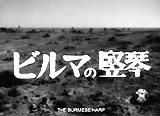
|
The Burmese Harp (1956,
Jp.)
In director Kon Ichikawa's haunting black and white
anti-war drama with musical elements; it was adapted from the 1946
post-war children's novel of the same name by Michio Takeyama,
to teach children about the ideals of Buddhism; its fable-like story
was a meditation upon evil, the devastating aftermath and horrors
of the chaos of war, the mystery of why mortals suffer, and spiritual
awakening; the narrator described it as "a story we shall never forget";
the film was remade in color (and was 17 minutes longer) by the same
director as The
Burmese Harp (1985):
- "The soil of Burma is red, and so are its
rocks" - the film's sparse and enigmatic opening words were a metaphoric
description of the dying and suffering human soul
- at the close of the Pacific theatre of WWII in July
of 1945, a group of weary Japanese soldiers, exhausted by years
of war and fighting in Burma, were retreating and planning
to return to Japan; the group of soldiers in a regiment
was led by Captain Inouye (Rentarō Mikuni), a compassionate
and thoughtful music school graduate and teacher-scholar
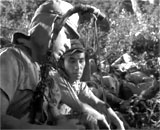
Mizushima Playing Harp For His Regiment
|
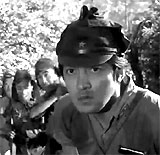
Regiment Captain Inouye
|
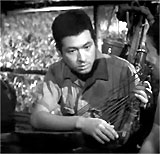
Mizushima With His Harp
|
- as they traversed
through the Burmese jungle, the Captain taught his platoon choral
music, to develop camaraderie, group unity, and to lift spirits
and improve morale; they sang nostalgic homeland songs with
music provided by self-taught, Burmese harp-playing Private
First Class Mizushima Yasuhiko (Shoji Yasui), the regiment's scout,
who played his hand-crafted Burmese harp - with haunting melodies
- when they found themselves in a peasant
village surreptitiously observed
and surrounded by a group of British and Indian soldiers, the Japanese
soldiers began to pretend that they were blithely unaware of the
enemy closeby: ("And get ready for action as we sing"); they began
to sing, dance and clap to Mizushima's playing of the Japanese
folk song: "Hanyuu no Yado";
to their surprise, the British joined them by serenading them with
a variation of their song - their own: "Home! Sweet Home!";
they learned that night that their nation had surrendered three
days earlier and the war was officially over, so they peacefully
laid down their arms
- before escorting the captured
Japanese soldiers to the Allied POW camp, the
British leader was convinced to send one soldier - Mizushima -
who volunteered - to talk to a resistant and besieged group of Japanese
soldiers who refused to quit fighting up in Triangle Mountain,
a half a day's trek away
- on a peace mission, Mizushima was given a 30 minute
cease-fire deadline by the British to urge the
group to surrender in their fortress; he argued to the resistant
troops that Japan had already surrendered and "further resistance
is useless," but they counter-argued: "Surrending is an insult
to those who've died"; although Mizushima claimed that they would
die needlessly and in vain, the holdouts unanimously vowed to suicidally
fight to the bitter end, and that Mizushima was the "filthy coward"
- Mizushima created a white truce
flag to postpone the bombing, but was restrained; the British destroyed
the cave where the hold-outs were encamped and killed the entire
squadron, but the wounded Mizushima regained consciousness and
emerged from the pile of bodies in the cave - he was the sole
survivor
- the captured Japanese regiment led by Captain Inouye
was marched to the British prison work
camp in Mudon about 200 miles to the south; the men remained curious
about the fate of their comrade, and began
to suspect that Mizushima might still be alive (a look-alike monk
with a parrot was thought to be Mizushima during a chance encounter
while crossing a bridge); however, a
local elderly, bartering village woman (Tanie Kitabayashi) relayed
information to them that their unit's fellow soldier was presumed
dead - they could only conclude: "The only thing we could
believe was that he'd died in battle"
- meanwhile, it was revealed that Mizushima had been
rescued and cared for by a Buddhist monk; in order to rejoin his
fellow soldiers without being identified as a soldier, he took
the monk's monastic robes and shaved his head; barefooted and soon
starving, he began an itinerant journey through the countryside to
be reunited with his regiment in Mudon; poor villagers along the
way gave him gifts of food and sandals
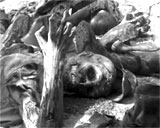
|
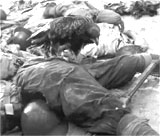
|
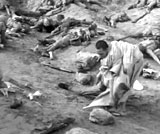
|
|
Mizushima Discovered Unburied and Abandoned Corpses
of Japanese War Casualties with Vultures
|
- he was horrified by the sight of
the unburied and abandoned corpses of hundreds of Japanese war
casualties on a hillside, with vultures lurking nearby; he went
about honoring the dead by saluting and
burying some of them in mass burial mounds or graves
- Mizushima experienced a spiritual transformation after he saw another victim, with a photo
of the dead soldier with his child - and suddenly realized the tragic
waste and devastating personal effects of death; at the shoreline,
he saw another massive pile of corpses and was horrified by the sight
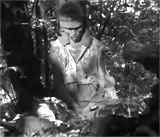
Dead Japanese Soldier
|
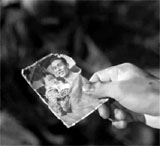
A Photo of the Soldier With His Son
|
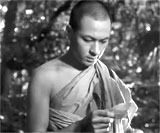
Mizushima's Moment of Realization
|
|
Moment of Spiritual Transformation
|
- he made his way on a boat to
a Buddhist temple near Mudon to become a reclusive monk in hiding near
the POW camp; he was tempted to join with his regiment of soldiers
there, but then turned away; he was overjoyed when he met a young
boy (Yôji Nagahama) with a Burmese harp;
in exchange for playing the harp, he promised to teach the boy
to play better so that he could earn more money in tips; he also
came upon a church graveyard with white crosses; during a prayer
ceremony of nuns, he noticed the grave of an unknown Japanese
soldier
- haunted by the overwhelming images of the dead,
Mizushima decided to dedicate and devote himself to finishing the task of burying
all of the left-behind corpses of fallen Japanese soldiers; he
would assume the duties of a typical Buddhist monk, to choose a path of altruism,
healing and self-reflection for his life
- with a parrot on his shoulder, he was on his way
back to bury more corpses at the shoreline when he encountered
his regiment crossing a bridge (shown earlier, but with more context
in this second reveal); some had suspected that he was Mizushima
("So...that monk was Mizushima after all, but we
weren't to know that at the time"); Mizushima thought to himself:
"I know now that I can never go back with them"
- at the shoreline, his tireless example of burying
more bodies inspired others to join in his mission to give every
corpse a decent send-off
- after Mizushima found a large, rare rough ruby by
the river bank and held it in the palm of his hand, he was told:
"It must be the spirit of the dead"; he grasped it and held it
close to his heart
- one day as the regiment was in the courtyard of
Mudon's Buddhist temple, Captain Inouye and some of the other soldiers
thought they heard Mizushima's style of harp music being played
- they discovered that the harp was being played by the boy that
he had tutored: ("That music, it's a harp....It's the way
it's being played, the arrangement of the notes together. That's
how Mizushima played it. It's that kid we saw at the temple");
the Captain suggested finding the boy and asking him who taught
him the melody, but they were stopped
- however, the Captain's men were inspired to continue
searching to find him, and doubted the news of his brave death
at Triangle Mountain; the men began to wonder and speculate why
Mizushima wouldn't speak to them, if indeed it was him on the bridge:
"If Mizushima is alive, is there any reason he wouldn't want to
return to his unit?"; some speculated that Mizushima might have
deserted: "I've seen deserters pose as monks"; others suggested
that it would be detrimental to continue to worry about Mizushima
and dishonor his spirit, although many were still doggedly interested
in locating their fellow soldier
- however, shortly later, a procession of monks through
the Mudon temple included a suspicious Mizushima look-alike who
was conspicuously seen carrying a white box of
ashes of the dead (with the huge ruby inside) - a Japanese funerary
custom; it was Mizushima's way of honoring war dead by denying material
wealth and showing respect for the ultimate human sacrifice
- to entice the stubborn-minded Mizushima to join
them, a parrot was instructed to say: "Hey, Mizushima! Let's
return to Japan together"; then, the regiment
heard the news that they would be leaving in three days to return
back to Japan - but then many asked themselves whether Mizushima
might be joining them; efforts to loudly sing choral songs to lure
Mizushima out of hiding failed when the men turned hoarse
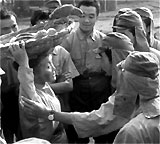
Elderly Woman with Parrot to be Given to Mizushima
|
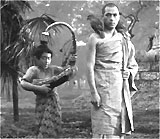
Mizushima Outside the POW Gate
|
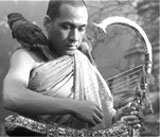
Playing the Harp
|
- a
local elderly, bartering village woman (Tanie Kitabayashi) was asked
to deliver the talking parrot to the wandering, highly-revered
monk; the day before their departure from the POW camp, the
robed Mizushima appeared outside the fenced gate with two parrots,
the young boy, and the burmese harp; he accompanied the troops'
singing by playing on the harp, and the men reacted joyfully that
they had finally found him; but then he turned and quietly returned
to the temple
- the morning of their POW's departure, Mizushima responded
by exchanging his own parrot through the old woman; the bird had
been trained to answer: "No, I can't go back"; he also sent a lengthy
letter that he had composed, but the Captain refused to read it due
to their imminent departure
- in an almost six-minute sequence, the letter was
finally read by Captain Inouye to his men on their ship returning to
Japan; it explained why Mizushima couldn't return to his beloved
homeland of Japan - he had become dedicated to join the priesthood,
adopt the Buddhist lifestyle and live a peaceful life,
to ease the suffering, and to have the courage
and the strength to create peace; he would
remain to continue burying the bodies and one day, might be
able to return to his war-ravaged country if possible, but probably
not ("My life may end here")
- an excerpt from Mizushima's explanatory letter:
("As I climbed mountains and crossed rivers, burying the
bodies left in the grasses and streams, my heart was wracked with
questions: 'Why must the world suffer such misery? Why must there
be such inexplicable pain?' As the days passed, I came to understand.
I realized that, in the end, the answers were not for human beings
to know, that our work is simply to ease the great suffering of
the world. To have the courage to face suffering, senselessness
and irrationality without fear, to find the strength to create
peace by one's own example. I will undergo whatever training is
necessary for this to become my unshakable conviction")
- he also mentioned that the parrot he kept still squawked:
"Hey, Mizushima, let's return to Japan together";
he thanked his fellow soldiers who were still thinking of him,
and although lonely and relinquishing any national identity, he
said he would be comforted by his harp-music; he ended the letter
with thanks and a prayer for the mens' happiness; although the
letter was deeply moving to the men, their thoughts soon turned
to what their own lives would be like once they returned to Japan
- the film's final image was of Mizushima wandering
and walking alone on the landscape of a Burmese plain, and the words
from the film's opening: "The soil of Burma is red,
and so are its rocks"
|
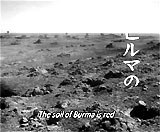
"The soil of Burma is red..."
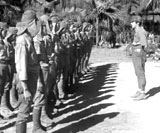
The Captured Japanese POWs
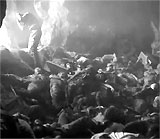
Mizushima - The Only Survivor of Bombarded Japanese Holdouts in Cave
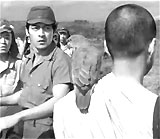
Chance Encounter While Crossing a Bridge With Shaved Monk and Parrot -
Was it Mizushima?
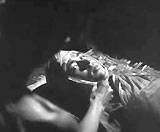
Injured Mizushima Cared For by Burmese Buddhist Monk
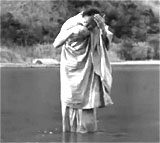
Shaving His Head and Wearing Stolen Monk's Buddhist Robes
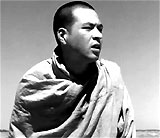
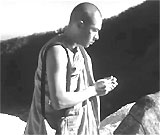
On His Trek to Mudon POW Camp
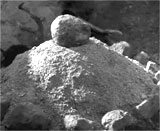
One of Mizushima's Burial Mounds or Graves for Dead Japanese Soldiers
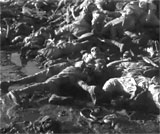
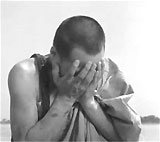
The Horror of More Bodies Along the Shoreline
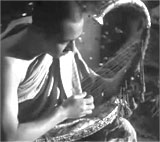
Monk Mizushima Playing a Burmese Harp
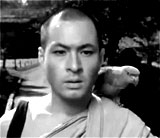
On the Bridge as a Monk - When He Encountered His Own Regiment
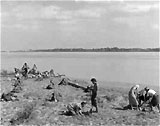
At the River's Shoreline, He Inspired Others to Help Him in His Mission
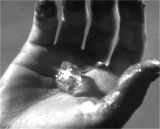
Mizushima's Discovery of Rough Ruby at River
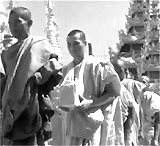
Procession of Monks - Mizushima Was Carrying A Box of Ashes
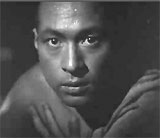
Mizushima Tormented About Returning to Regiment or Not
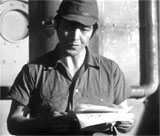
On the Ship Back to Japan, Captain Inouye Read Mizushima's Letter to the
Men
|



















